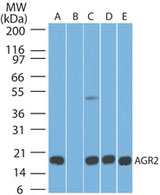AGR2 Antibody (aa50-100, clone IMG10E2)
Mouse Monoclonal Antibody
- SPECIFICATION
- CITATIONS
- PROTOCOLS
- BACKGROUND

Application
| WB, IHC-P |
|---|---|
| Primary Accession | O95994 |
| Reactivity | Human, Mouse, Horse, Bovine, Dog |
| Host | Mouse |
| Clonality | Monoclonal |
| Clone Names | IMG10E2 |
| Calculated MW | 20kDa |
| Dilution | IHC-P (10 µg/ml), WB (4-6 µg/ml), |
| Gene ID | 10551 |
|---|---|
| Other Names | Anterior gradient protein 2 homolog, AG-2, hAG-2, HPC8, Secreted cement gland protein XAG-2 homolog, AGR2, AG2 |
| Target/Specificity | Human AGR2 |
| Reconstitution & Storage | Store at 4°C for short term applications. For long term storage, aliquot and store at -20°C. |
| Precautions | AGR2 Antibody (aa50-100, clone IMG10E2) is for research use only and not for use in diagnostic or therapeutic procedures. |
| Name | AGR2 |
|---|---|
| Synonyms | AG2 |
| Function | Required for MUC2 post-transcriptional synthesis and secretion. May play a role in the production of mucus by intestinal cells (By similarity). Proto-oncogene that may play a role in cell migration, cell differentiation and cell growth. Promotes cell adhesion (PubMed:23274113). |
| Cellular Location | Secreted. Endoplasmic reticulum {ECO:0000250|UniProtKB:O88312} |
| Tissue Location | Expressed strongly in trachea, lung, stomach, colon, prostate and small intestine. Expressed weakly in pituitary gland, salivary gland, mammary gland, bladder, appendix, ovary, fetal lung, uterus, pancreas, kidney, fetal kidney, testis, placenta, thyroid gland and in estrogen receptor (ER)-positive breast cancer cell lines |

Thousands of laboratories across the world have published research that depended on the performance of antibodies from Abcepta to advance their research. Check out links to articles that cite our products in major peer-reviewed journals, organized by research category.
info@abcepta.com, and receive a free "I Love Antibodies" mug.
Provided below are standard protocols that you may find useful for product applications.
Background
Required for MUC2 post-transcriptional synthesis and secretion. May play a role in the production of mucus by intestinal cells (By similarity). Proto-oncogene that may play a role in cell migration, cell differentiation and cell growth.
References
Thompson D.A.,et al.Biochem. Biophys. Res. Commun. 251:111-116(1998).
Zhang J.S.,et al.Submitted (DEC-1998) to the EMBL/GenBank/DDBJ databases.
Fan Y.X.,et al.Submitted (JUL-2003) to the EMBL/GenBank/DDBJ databases.
Clark H.F.,et al.Genome Res. 13:2265-2270(2003).
Kalnine N.,et al.Submitted (MAY-2003) to the EMBL/GenBank/DDBJ databases.
If you have used an Abcepta product and would like to share how it has performed, please click on the "Submit Review" button and provide the requested information. Our staff will examine and post your review and contact you if needed.
If you have any additional inquiries please email technical services at tech@abcepta.com.













 Foundational characteristics of cancer include proliferation, angiogenesis, migration, evasion of apoptosis, and cellular immortality. Find key markers for these cellular processes and antibodies to detect them.
Foundational characteristics of cancer include proliferation, angiogenesis, migration, evasion of apoptosis, and cellular immortality. Find key markers for these cellular processes and antibodies to detect them. The SUMOplot™ Analysis Program predicts and scores sumoylation sites in your protein. SUMOylation is a post-translational modification involved in various cellular processes, such as nuclear-cytosolic transport, transcriptional regulation, apoptosis, protein stability, response to stress, and progression through the cell cycle.
The SUMOplot™ Analysis Program predicts and scores sumoylation sites in your protein. SUMOylation is a post-translational modification involved in various cellular processes, such as nuclear-cytosolic transport, transcriptional regulation, apoptosis, protein stability, response to stress, and progression through the cell cycle. The Autophagy Receptor Motif Plotter predicts and scores autophagy receptor binding sites in your protein. Identifying proteins connected to this pathway is critical to understanding the role of autophagy in physiological as well as pathological processes such as development, differentiation, neurodegenerative diseases, stress, infection, and cancer.
The Autophagy Receptor Motif Plotter predicts and scores autophagy receptor binding sites in your protein. Identifying proteins connected to this pathway is critical to understanding the role of autophagy in physiological as well as pathological processes such as development, differentiation, neurodegenerative diseases, stress, infection, and cancer.


